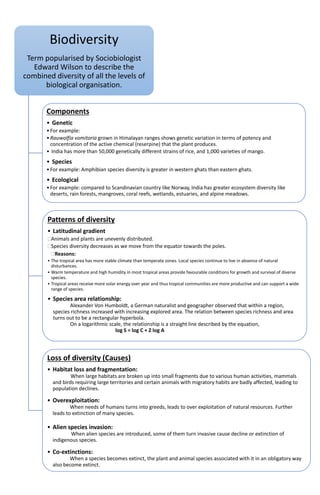
Biodiversity defined as biological diversity
- 1. Biodiversity Term popularised by Sociobiologist Edward Wilson to describe the combined diversity of all the levels of biological organisation. Components • Genetic •For example: •Rauwolfia vomitoria grown in Himalayan ranges shows genetic variation in terms of potency and concentration of the active chemical (reserpine) that the plant produces. • India has more than 50,000 genetically different strains of rice, and 1,000 varieties of mango. • Species •For example: Amphibian species diversity is greater in western ghats than eastern ghats. • Ecological •For example: compared to Scandinavian country like Norway, India has greater ecosystem diversity like deserts, rain forests, mangroves, coral reefs, wetlands, estuaries, and alpine meadows. Patterns of diversity • Latitudinal gradient Animals and plants are unevenly distributed. Species diversity decreases as we move from the equator towards the poles. Reasons: • The tropical area has more stable climate than temperate zones. Local species continue to live in absence of natural disturbances. • Warm temperature and high humidity in most tropical areas provide favourable conditions for growth and survival of diverse species. • Tropical areas receive more solar energy over year and thus tropical communities are more productive and can support a wide range of species. • Species area relationship: Alexander Von Humboldt, a German naturalist and geographer observed that within a region, species richness increased with increasing explored area. The relation between species richness and area turns out to be a rectangular hyperbola. On a logarithmic scale, the relationship is a straight line described by the equation, log S = log C + Z log A Loss of diversity (Causes) • Habitat loss and fragmentation: When large habitats are broken up into small fragments due to various human activities, mammals and birds requiring large territories and certain animals with migratory habits are badly affected, leading to population declines. • Overexploitation: When needs of humans turns into greeds, leads to over exploitation of natural resources. Further leads to extinction of many species. • Alien species invasion: When alien species are introduced, some of them turn invasive cause decline or extinction of indigenous species. • Co-extinctions: When a species becomes extinct, the plant and animal species associated with it in an obligatory way also become extinct.
- 2. Conservation Reasons • Narrowly utilitarian •They provide direct economic benefits from nature like food, firewood, fibre, construction material, industrial products and products of medicinal importance. • Broadly utilitarian •20 percent of the total oxygen in the earth atmosphere are released through photosynthesis by the rich biodiversity of Amazon forest. • Ethical •We share biodiversity with millions of plant, animal and microbe species. Every species has an intrinsic value, even if it may not be of any economic value to us. We also have a moral duty to care for their well-being and pass on our biological legacy in good order to future generations. Approaches • In-situ conservation •Involves protection of endangered species in their natural habitat. "Biodiversity hotspots" regions with very high level of species richness and high degree of endemism. •EX: National parks, biosphere reserves, wildlife sanctuaries, etc., • Ex-situ conservation •The organism is taken out of its natural environment and placed in special settings and given special care (man-made habitat). •Ex: Gene banks, like seed banks, field banks and sperm and ova banks. • In vitro plant tissue and microbial culture collections; • Captive breeding of animals and artificial propagation of plants, with possible reintroduction into the wild • Collecting living organisms for zoos, aquaria, and botanic gardens for research and public awareness.